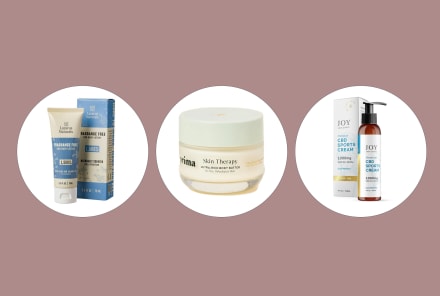Advertisement
Forcing Myself To Love My Body Didn’t Work. Here’s What I Did Instead


Up until I was about 14 years old, I saw food solely as enjoyment. I used to get really excited when invited to a friend's house to play, not just for the companionship but for the chance to raid their cupboards for all those delicious sugary snacks my mom never kept around. Food was quite literally fun to me, and eating only produced feelings of happiness (unless, of course, I ate too much).
Back in those days, the shape or state of my body was never something I thought about or something that I could fathom having negative or positive feelings toward. Why would I care? It just helped me play and enjoy food and stuff. Though, at some point, feelings did indeed start setting in, and let me tell you, they were less than joyful. Over time, the food I once so thoroughly delighted in devouring began producing feelings of guilt, shame, and anxiety. But why?
Unrealistic role models.
Like many (most) women, as I got older, I became more aware of my surroundings, and my surroundings consisted of ads featuring unattainable bodies, targeted marketing campaigns for fad diets, movies and television shows featuring beyond-beautiful actresses, and other, older, cooler teenage girls talking about how they all needed to lose 10 pounds for some reason. In a short period of time, I went from not thinking about my body to desiring a body other than my own in order to meet the sky-high expectations I was regularly exposed to.
Body positivity is hard for me, and this fact actually makes me feel worse when it comes to my body image—I feel bad that I don’t love my aforementioned flaws.
In order to attain this aesthetic perfection, I tried the fad diets, I started exercising regularly, I weighed myself, I did everything right. What happened? I still had the same body, perhaps with a little less fat and a bit more muscle tone. Did I diet my way to massive breasts, a pencil-thin waist, and a luscious backside? Not quite—goal of ever becoming Adriana Lima’s body double = not achieved.
Body positivity?
After becoming painfully exhausted from years of trying to change the way I looked with, in my mind, unsatisfactory results, I stumbled upon a then-foreign concept: the Body Positive movement. The idea of body positivity is exactly what it sounds like—it encourages women to love their bodies unconditionally and to value themselves beyond their outward appearance. It preaches the idea that your body is beautiful, no matter its shape, size, or number of perceived "flaws," and that one should lovingly accept all of the above.
The Body Positive movement is amazing in theory. Loving your whole self unconditionally, body included, is a beautiful, wonderful way to live your life—and if you can do it, more power to you, girlfriend (or boyfriend)!
But, for me at least, when it came to truly LOVING my body…I struggled. I still struggle. I’m a perfectionist. My mind often works in black-and-white, and to me, there’s always room for improvement. Don’t get me wrong: I’m so grateful for what my body allows me to do every day, the health it provides me, and for quite literally giving me life—I have so much gratitude for that. But as far as the way it looks, I’m human, and I’m still slightly annoyed by my cellulite, stretch marks, disproportions (by societal standards, at least), and then some. Body positivity is hard for me, and this fact actually makes me feel worse when it comes to my body image—I feel bad that I don’t love my aforementioned flaws. The negative-feelings factor is now doubled.
Neutral territory.
Therein lies the issue: Why can’t I just net out somewhere in the middle? Why can’t I just stop obsessing about my body, full stop? Am I allowed to not love or hate my body? Is it OK to just not exert any extra emotional energy toward it? Emotional energy is valuable and must be rationed wisely—directing a good chunk toward my body, whether negatively or positively, does not seem to be the best use of it. Enter: body neutrality.
Sure, being happy as often as possible isn’t a bad thing, but being neutral allows your mind and emotions to rest—to find calm, balance, and inner peace.
Body neutrality, like body positivity, is also exactly what it sounds like. It’s when you feel relaxed about your body and not defined by it in any way. You’re not stressed about the way it looks, you’re not obsessing over your diet, and exercise is something you do for your health, not for a thigh gap. Body neutrality is not an absence of caring about your body—it’s simply about letting it be as it is, with no (or as little as possible) emotional association with its appearance. Think of it as the middle ground between body shaming and body positivity—or, as I prefer to think of it, kind of like Buddhism for your body image.
What does Buddhism have to do with body image?
I wouldn’t call myself a Buddhist, as I haven’t spent enough time studying its ins and outs, but I did travel Asia for a fairly extensive period of time, I meditate daily, and the knowledge that I do have of the practice impresses me immensely. Because of Buddhism, I have come to truly understand the art of mindfully letting go—letting go of judgment, fear, worry, and stress (though, that’s not to say I am always able to). I have become more mindful of all things in my life, from the feel of the air I breathe to my stress levels at work to sensations in my limbs at any given time. I’ve also learned to calm my mind when it screams at me for not looking like Heidi Klum in a swimsuit, when it makes me feel guilty for not being as thin as I was 10 years ago, or, in a nutshell, when it tells me that I’m not good enough. I am now able to recognize these feelings and then to let them go (most of the time)—literally watch them dissolve into oblivion and bring myself back to equilibrium. When those nasty emotions are gone, what am I left with? My body—the body that sustains me and allows me to live my life, the body that I don’t necessarily love or hate aesthetically, but the body that just is—the body that allows me to get to the important stuff.
Approaching things with a neutral mindset isn’t just useful for body image but is often the fastest path to contentment in life in general. Sure, being happy as often as possible isn’t a bad thing, but being neutral allows your mind and emotions to rest—to find calm, balance, and inner peace. It gives you back control of said emotions, helps alleviate stress, and allows you to truly understand what matters to you—and trust me, when you get to this state, what you look like doesn’t matter. It is in these moments that you find truth.
Just be (at peace).
So next time you’re in a less-than-stellar mood and hating on yourself or someone or something else, take a pause to really determine whether it’s worth getting up in arms about. Does it really matter if your thighs are bigger than those of your favorite actress or your ex’s new girlfriend? Or that your pants from five years ago feel a bit snug? What would happen if you just reacted in a neutral manner? Expending emotion is expending energy, and isn’t energy something we’re all trying to get more of?
Live between the two extremes because your peace—with your body and otherwise—lies in that neutral territory.
Watch Next
Enjoy some of our favorite clips from classes
Enjoy some of our favorite clips from classes
What Is Meditation?
Mindfulness/Spirituality | Light Watkins
Box Breathing
Mindfulness/Spirituality | Gwen Dittmar
What Breathwork Can Address
Mindfulness/Spirituality | Gwen Dittmar
The 8 Limbs of Yoga - What is Asana?
Yoga | Caley Alyssa
Two Standing Postures to Open Up Tight Hips
Yoga | Caley Alyssa
How Plants Can Optimize Athletic Performance
Nutrition | Rich Roll
What to Eat Before a Workout
Nutrition | Rich Roll
How Ayurveda Helps Us Navigate Modern Life
Nutrition | Sahara Rose
Messages About Love & Relationships
Love & Relationships | Esther Perel
Love Languages
Love & Relationships | Esther Perel
What Is Meditation?
Box Breathing
What Breathwork Can Address
The 8 Limbs of Yoga - What is Asana?
Two Standing Postures to Open Up Tight Hips
How Plants Can Optimize Athletic Performance
What to Eat Before a Workout
How Ayurveda Helps Us Navigate Modern Life
Messages About Love & Relationships
Love Languages
Advertisement

8 Dietitians Share The Nutrition Advice They Actually Follow
Molly Knudsen, M.S., RDN

Why Women Are Twice As Likely To Struggle With Depression & Anxiety
Phyllis E. Greenberger, MSW

8 Dietitians Share The Nutrition Advice They Actually Follow
Molly Knudsen, M.S., RDN

Why Women Are Twice As Likely To Struggle With Depression & Anxiety
Phyllis E. Greenberger, MSW













